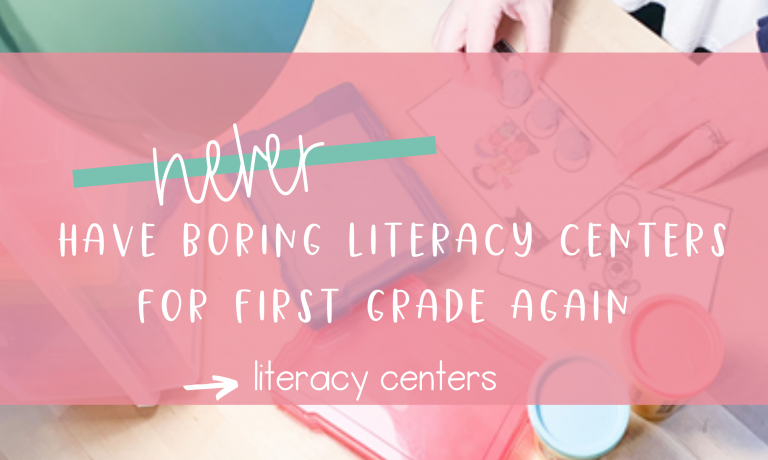Never Have Boring Literacy Activities for First Grade Again!
Literacy activities for first grade were my favorite part of the day as a classroom teacher! I loved being able to build stronger relationships with my guided reading group and watch the rest of my students become independent learners.
But this wasn’t always the case. That first year in first grade I thought I would never find a way to make literacy activity centers work. You see, I had been a second grade teacher for 3 years and was so used to their independence. I quickly found out that first grade literacy centers are a whole different ball game!
Coming Up With a Plan
So, I had to come up with a system that would allow my students to work independently and not interrupt my guided reading group.
After trying a million different things, I came up with a simple 6 step system to create meaningful literacy activities for first grade. These 6 steps ensure that my literacy centers have a purpose and will nurture my students’ love of reading. You can get my 6 Steps to Creating First Grade Literacy Centers here for FREE!!
The workbook is full of great tips I learned from trial and error and from my teacher besties. (Seriously wouldn’t be here today without my amazing first grade team 🥰)
Once I utilized these 6 steps for creating literacy activities for first grade I had the confidence to run my center time stress-free, and you can too!! In my free workbook, I go into detail about each step, you can download it here 📚
Building Our Literacy Activity Routine
Once I had a system in place my students knew what our daily routine was, and were able to complete their work independently. A huge part of my new center creation was to make sure that they were multisensory. Making literacy tangible for my students helps to build stronger pathways in the brain.
While I meet with my small group for guided reading, the other 4 groups are working at different stations around the room. All our literacy centers are made up of review skills, and I use the same 16 centers all year. (We do 4 centers a week, so students complete all 16 centers each month.) This allows my students to be familiar with the center and instructions even when I change the phonics skill.
I break my students up into homogeneous groups because I can easily differentiate materials for each group. This year I had 5 groups with 4 students in each group. Keeping my groups small allows me to get to know my students better when I meet with them for guided reading.
A Typical Monday
Here’s what a typical Monday looked like in my classroom!

Group 1 starts their week with a phonemic awareness literacy center. First graders need a lot of practice with phonemic awareness, such as producing, blending, isolating, and manipulating sound. In this activity, students smash a playdough ball for each sound, then blend the sounds together to create the word that matches the picture.

Group 2 works on a phonics center that focuses on words with the same vowel pattern. In this activity, students tap out and blend words to find the rhyming word.

Group 3 starts their week with a reading center where they read sentences with words that follow the same vowel pattern. Students practice reading short sentences then find the picture that is the best match.

Group 4 works on a writing center where they fix up sentences that follow the same vowel pattern. Students focus on sentence components like capitals, finger spaces, spelling, and punctuation.
Group 5 is with me working on guided reading. The activities I do with my groups target the needs of each group.
Students keep all of their literacy center work in their Ketchup folders, which I check weekly. You can read more about how I use Ketchup folders here.
I’d love to help you create your own first grade literacy centers that allow you to nurture your students’ love for reading! Download your FREE workbook to get started!
You are doing amazing things for your students every day and I’m so proud of you! 🌠
Happy creating,
Alexandra



5 Responses
I love the hands on activities you use. How do you hold the students accountable and know that they are doing the activity correctly. Example: using the play dough for blending words. How do you know they are saying the sounds correctly. Same with the rhyming cards and fix it. I love all those activities, but I think of my lower students who might not do these activities correctly. Any advice would be appreciated!!!!!
Hi there Kim! My students love to use hands-on activities and we go over rules and expectations for each literacy center. For my low level students I preview the activities with them in my small group. Then when it is their turn for independent centers they will repeat the center that we did together. For my centers that focus on phonemic awareness, I do check-ins during centers and ask them to tap out a few cards for me. You are correct that they may tap or rhyme a word incorrectly at times, but as long as they are trying their best and having fun with literacy it’s ok! But like I said, to cut down on confusion/mistakes try previewing the center with your students before it’s their turn to work on it by themselves! Completing a center multiple times will only strengthen their understanding!